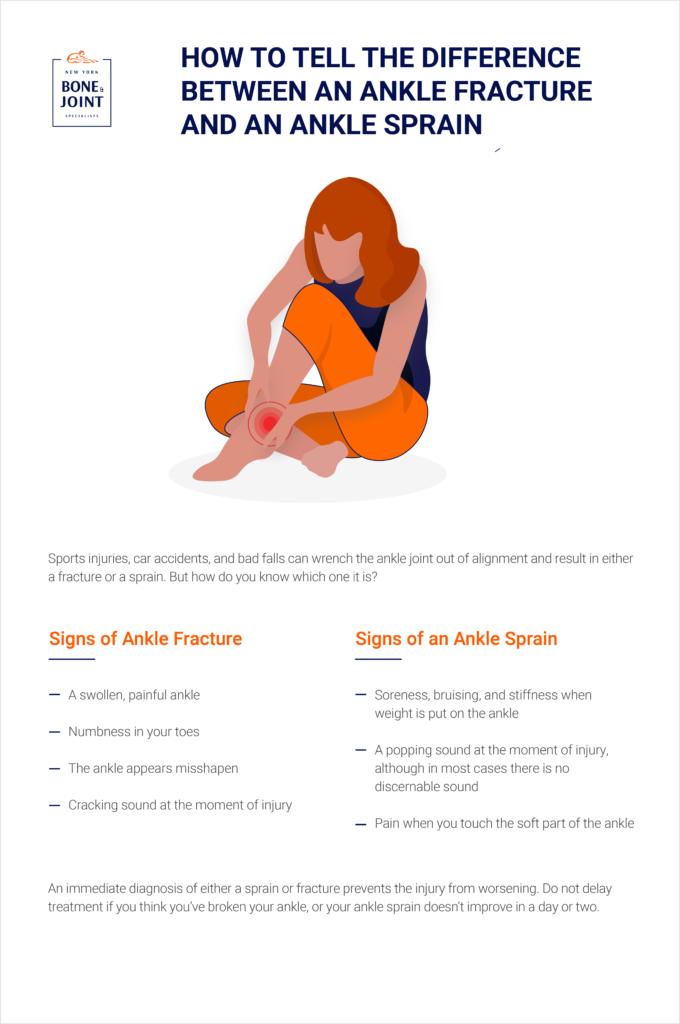Do you have an ankle sprain or an ankle fracture? Learn how to spot the signs for each condition.
Considering how much weight our ankles carry and the mobility this hard-working joint provides, it’s not surprising that ankle sprains and fractures are quite common. Sports injuries, car accidents, and bad falls can wrench the ankle joint out of alignment and result in either a fracture or a sprain. But how do you know which one it is?
Severe pain, swelling, and impaired mobility all indicate significant ankle trauma. An orthopedic specialist can determine with an X-Ray or other imaging tests whether your ankle is sprained or broken. But before you book your appointment, here are some clues as to which injury you may have suffered.
Ankle Sprain Vs. Fracture
Both injuries cause similar symptoms — pain, swelling, and an inability to put weight on the joint. At the same time, there are some key differences. It’s important to know these differences and get a quick diagnosis so you can receive the proper treatment.
Ankle Fracture. Your ankle consists of three main bones: the tibia (shinbone), fibula (lower leg), and the ankle bone (talus). All three join together at the ankle to give the joint its wide range of motion. Ankle fractures occur most often due to a car accident or a severe fall that breaks or chips one or all three bones. A swollen, painful ankle is a sign of an ankle fracture, particularly if the area over the ankle bone is tender to the touch. If you’ve fractured your ankle, you may also experience numbness in your toes and notice your ankle appears misshapen. An ankle fracture is usually accompanied by a cracking sound.
Ankle Sprain. Holding the ankle bones together is a network of flexible but strong ligaments. When those ligaments are stretched or twisted beyond their normal range of motion, they can become strained, partially torn, or completely torn. Soreness, tenderness, bruising, swelling, stiffness, and pain when trying to put weight on the ankle are signs of an ankle sprain. Depending on the severity of the sprain, you may hear a popping sound, although in most cases there is no discernable sound. If you feel pain when you touch the soft part of the ankle, it’s most likely a sprain.

How to Treat Ankle Fractures and Sprains
An immediate diagnosis of either a sprain or fracture prevents the injury from worsening and doing more damage to the ligaments or bones. Do not delay treatment if you think you’ve broken your ankle, or your ankle sprain doesn’t improve in a day or two.
Treatment for an ankle sprain begins with the PRICE method: Protecting the ankle from further harm, Rest, Ice, Compression, and Elevation. You may need to wear to a brace to support the ankle and use crutches to take weight off the joint as you heal. Over-the-counter pain medications can alleviate the discomfort. Mild sprains clear up in about two weeks, but it may take longer for more significant sprains to heal. Surgery is not recommended unless there is a severe ligament tear. Physical therapy can also help restore flexibility and range of motion to the joint.
How an ankle fracture is treated depends on whether the bone is stable — meaning it’s broken but not out of alignment — or knocked out of place. A stable fracture can heal in about six weeks immobilized in a cast. If the bones are shattered into small bits and/or out of place, surgery may be necessary to attach the bones together with plates, screws, rods, or wires in a procedure known as reduction. Similar to ankle sprains, treatments for fractures include PRICE, taping around the ankle or a boot to stabilize the joint, crutches while walking to reduce pressure on the ankle, and physical therapy to strengthen and increase flexibility in the joint.
Treat Your Ankle at New York Bone & Joint
Ankle injuries can be especially debilitating. Fortunately, the physicians and physical therapists at New York Bone & Joint Specialists have years of experience in diagnosing and treating orthopedic injuries like ankle sprains and fractures. We use the latest equipment and techniques to quickly heal your ankle. Contact us today to set up an appointment.




